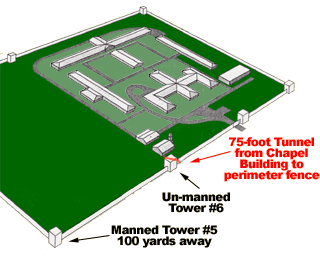1995
OFFENDER POPULATION JUNE 30, 1995: INMATES: 61,992
SUPERVISED: 136,056
SUPERVISED: 136,056
Inmates are serving more time behind bars, especially violent criminals, drug traffickers and sex offenders. The legislature passes new legislation to require all offenders committing crimes on or after October 1, 1995, to serve 85% of their sentences. Exceptions: those sentenced to life will serve their entire lives in prison, and those sentenced to death will die by execution. By December 31, 2001, more than half (65.7%) of all inmates in prison had been sentenced under the 85% law.
EDUCATION AND JOB TRAINING
The position of Assistant Secretary for Education and Job Training is created.
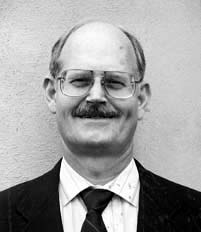
Wilson Bell, whose Education and Job Training Office absorbed the former Correctional Education School Authority, maintained a philosophy that" there are no problems, only opportunities."
In July 1995, the Correctional Education School Authority (CESA) is transferred to the department and becomes part of the FDC's Education and Job Training section under the human dynamo Wilson Bell.
 Nine-year-old Jimmy Ryce exits his school bus and is walking home when he is abducted, raped and killed by a local ranch hand. It would be three years before his killer is found and four years before a law bearing his name will be enacted to civilly commit violent sexual predators. Ryce’s murderer was executed February 12, 2014 after 16 years on death row.
Nine-year-old Jimmy Ryce exits his school bus and is walking home when he is abducted, raped and killed by a local ranch hand. It would be three years before his killer is found and four years before a law bearing his name will be enacted to civilly commit violent sexual predators. Ryce’s murderer was executed February 12, 2014 after 16 years on death row.
 Click here to hear Secretary Singletary discuss why he eliminated tours of death row and allowed victim's families to attend executions during his administration.
Click here to hear Secretary Singletary discuss why he eliminated tours of death row and allowed victim's families to attend executions during his administration.
 Click here to hear Secretary Singletary discuss his philosophy about the death penalty.
Click here to hear Secretary Singletary discuss his philosophy about the death penalty.
The Florida Corrections Commission is established by the Legislature. Its purpose is to "provide oversight to the state's correctional system and provide policy and budget recommendations to the Governor and Legislature," according to its mission statement.
ESCAPES FROM GLADES C.I. RESULT IN SECURITY UPGRADES STATEWIDE
At around 6:15 p.m., Monday, January 2, 1995, Florida had its largest prison break in 15 years. Six inmates from Glades Correctional Institution in Belle Glade escaped via a tunnel they dug beneath a chapel that was under construction on the compound. The tunnel was 8 feet deep, two feet wide and 25 yards long. A correctional officer noticed some of the inmates as they were making their getaway and fired two gunshots. None of the inmates were believed hit by gunfire. One inmate, Felix Carbonell, was apprehended almost immediately outside the prison fence.
Six inmates escape through a tunnel they spent three weeks digging. The tunnel ran from the Prison Chapel (which was near a construction site), under a concrete slab and returned to the surface outside the razor-wire perimeter fence.
Escape and recapture plans were immediately implemented, and the Belle Glade Police Department, Palm Beach Sheriff's Office and Highway Patrol were all assisting. Canine squads and helicopters from nearby agencies and prisons were also utilized.
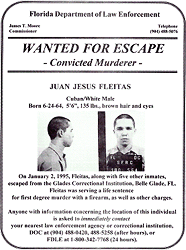
Juan Jesus Fleitas was free the longest, more than two years, before being spotted in Mexico and apprehended.

Armando R. Junco, at 62 the oldest of the six to escape, was shot and killed by police on July 10, 1995.
The remaining escapees were Hector Rivas, 32; Juan Fleitas, 30; Jesus Martinez, 47; Florencio Alvarez, 39; and Armando Junco, 62. All were serving life sentences with 25-year-mandatories. A tip from two citizens to a Florida Highway Patrol station led to the recapture of Alvarez and the death of Junco, who was shot by a Miami police officer during the recapture that included the Florida Department of Law Enforcement, the FBI and Miami and Metro-Dade police. Rivas was caught next, 10 days after the escape, by a patrol officer who spotted him walking in Little Havana. Martinez was caught the next day, also in Little Havana, when he made the mistake of walking in front of a patrol car and was recognized. Fleitas was not recaptured for over two years.
According to an article in the Miami Herald dated August 26, 1997 written by Frances Robles and Manny Garcia, Fleitas "remained on the loose until August 3, when Mexican police allege that he shot Dania Leva Fleitas during a bungled robbery. They are not related." Fleitas was going by the name Roberto Garcia Lopez and working as a waiter/busboy at a mall seafood restaurant in the Mexican city of Merida. Subsequent to the shooting, his picture was in the Merida newspaper and a tipster thought he looked a lot like fugitive Fleitas, featured on American's Most Wanted. The tipster called the FBI, fingerprints were exchanged and they matched. In May 2023, Fleitas is still serving his sentence in a Florida prison.
As a result of the escapes, a Florida Department of Law Enforcement investigation was conducted; a grand jury was convened; and the Department of Corrections conducted its own security assessment. All concluded that the Department needed both additional security equipment and staffing. The 1995 Legislature responded by providing $6.2 million for 197 positions to help increase the relief factor and $4.7 million for 180 security staffing positions focusing in the areas of inmate movement, emergency response, searches and confinement escort. The following fiscal year, the FDC was given an additional $6.2 million for 484 more security positions to help increase the relief factor from 1.573 to 1.66 and over $13 million in fixed capital outlay funds to improve or purchase electronic detection systems for all major institutions, fencing and razor wire, radios and perimeter vehicles.
 Click here to hear Secretary Harry K. Singletary describe the events of that day.
Click here to hear Secretary Harry K. Singletary describe the events of that day.
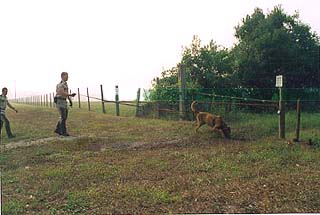
Correctional Officers conduct an escape drill.
Officer Jerome A. Williams was attending the Correctional Training Institute in Raiford, preparing to be a correctional officer. On July 26, 1995, Officer Williams and other institute attendees witness a man assaulting a fellow trainee in Starke, FL. Officer Williams attempts to talk him out of assaulting the woman. The assailant responds by firing at Officer Williams. Officer Williams is shot in the back three times and dies shortly thereafter.
In 1995 and 1996, Community Work Squads save Florida taxpayers over $21 million dollars.
A "Corrections Action Team," consisting of staff from key areas of the agency, is formed to review the possibility of creating a web site for the Florida Department of Corrections. The Internet was just making its debut as "freenets" became available to some communities through universities and colleges.
Everglades Correctional Institution (Miami, FL) and Okeechobee Correctional Institution (Okeechobee, FL) open.
Gadsden Correctional Facility (Quincy, FL), Bay Correctional Facility (Panama City, FL) and Moore Haven Correctional Facility (Moore Haven, FL) open as the first privately owned facilities in Florida to house state inmates under contract with the Dept. of Corrections. Each houses minimum/medium custody inmates.
Probation and Parole Services also open 500 diversion and non-secure substance abuse treatment beds at new and existing centers during FY 1994-95. Payments collected during FY 1994-1995 total $52,405,030.
The average percentage of sentence served by inmates released as of June 30 is 61.1%, a giant 18 percentage point increase from the previous year.
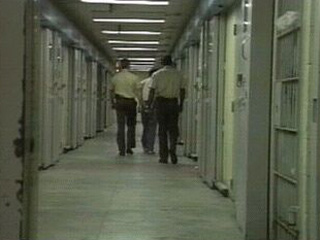
Close management at Union Correctional Institution

Food raised by inmates is shared with needy Florida citizens.

Inmates sort vegetables for the Farm Share program.
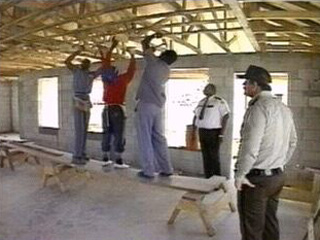
Inmates are used to construct government buildings.
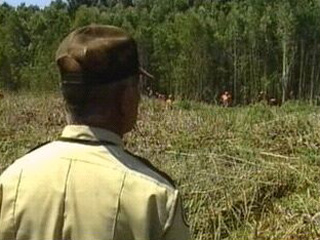
Inmates perform field work under the watchful eye of a Correctional Officer.

Inmates repair and maintain prison.
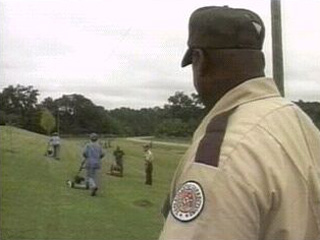
Inmates are responsible for all lawn and garden work at prisons statewide.

Inmates train seeing eye dogs.

Inmates help construct new prison facilities

Correctional Officers play a role in their communities.
- 1821-1845
- 1868-1876
- 1877-1895
- 1900-1919
- 1921
- 1922-1924
- 1927
- 1928-1931
- 1932 | CHAPMAN
- 1933-1935
- 1936-1939
- 1940-1945
- 1946-1949
- 1950-1955
- 1956-1961
- 1962 | WAINWRIGHT
- 1963-1965
- 1966-1969
- 1970-1975
- 1976-1979
- 1980-1986
- 1987 | DUGGER
- 1988-1990
- 1991 | SINGLETARY
- 1992-1995
- 1996-1998
- 1999 | MOORE
- 2000-2002
- 2003 | CROSBY
- 2004-2005
- 2006 | MCDONOUGH
- 2007
- 2008 | MCNEIL
- 2009-2010
- 2011 | BUSS
- 2011 | TUCKER
- 2012 | CREWS
- 2013-2014
- 2014 | JONES
- 2015-2018
- 2019 | INCH
- 2020-2021
- 2021 | DIXON
- 2022-Today
- Population Summary Table

